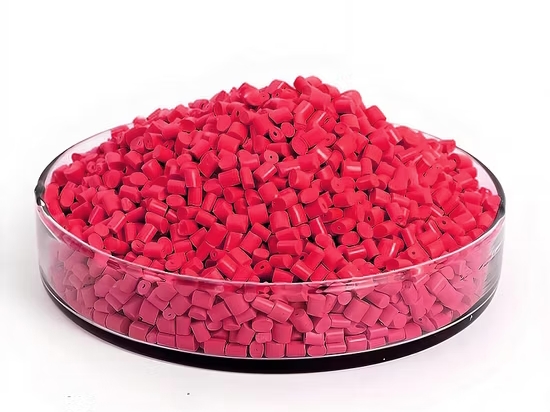Masterbatch plays a pivotal role in achieving vibrant colors and specialized properties in plastic products in the plastics industry. Masterbatches ensure compliance with stringent quality and performance standards, particularly in high-performance sectors such as packaging, automotive, and consumer goods.
This guide provides an in-depth exploration of masterbatch, including its definition, key benefits, various types tailored for different industries, and the critical processes of dispersion and dilution that ensure optimal performance.
What Is Masterbatch?
A masterbatch is a concentrated blend of pigments, additives, and a carrier resin designed for uniform dispersion in plastic manufacturing. It ensures precise coloration and enhanced material properties while simplifying production processes. Available in pellet, granule, or powder form, masterbatches are engineered for compatibility with various polymers, including polyethylene (PE), polypropylene (PP), and polystyrene (PS).

Composition of Masterbatch
-
Pigments (organic or inorganic) – Provide color and opacity.
-
Additives – Enhance functionality (e.g., UV stabilizers, flame retardants, anti-static agents).
-
Carrier Resin – Acts as a medium to evenly distribute pigments and additives into the base polymer.
This formulation guarantees consistent color matching and property enhancement, crucial for industries requiring high precision, such as medical devices and automotive components.
Key Advantages of Masterbatch
Masterbatch offers numerous benefits over traditional coloring methods:
✔ Customizable Formulations – Tailored to meet specific application needs, whether for food-safe packaging or flame-retardant automotive parts.
✔ Dust-Free Handling – Unlike powdered pigments, masterbatch eliminates airborne particles, improving workplace safety and cleanliness.
✔ No Skin Contact Risks – Encapsulated pigments reduce exposure hazards, ensuring safer handling for operators.
✔ Precision Dosing – Ensures accurate color matching and additive incorporation, minimizing waste.
✔ Elimination of Cross-Contamination – Prevents color bleeding and inconsistencies in multi-product production lines.
✔ Superior Dispersion – Ensures uniform color distribution without streaks or specks.
✔ Batch-to-Batch Consistency – Guarantees identical color and performance across production runs.
These advantages make masterbatch the preferred choice for manufacturers prioritizing efficiency, safety, and product quality.
Types of Masterbatch for Packaging, Automotive, and Consumer Goods
Masterbatches are engineered for specific industry requirements. Below are key categories:
Masterbatches for Packaging
Packaging demands high visual appeal and functional properties. Common types include:
-
Color Masterbatch – Used in food containers, bottles, and films for vibrant, fade-resistant hues.
-
White & Black Masterbatch – Provides opacity and UV protection for milk bottles and trash bags.
-
Additive Masterbatch – Enhances properties like anti-fog (for fresh produce packaging) and oxygen barrier (for extended shelf life).
Masterbatches for Automotive
Automotive components require durability and safety compliance:
-
Flame-Retardant Masterbatch – Used in cable insulation and interior trim to meet fire safety standards.
-
UV-Stabilized Masterbatch – Protects exterior parts from sun degradation.
-
Metallic & Special Effect Masterbatch – Creates high-gloss finishes for dashboards and trims.
Masterbatches for Consumer Goods
From electronics to household items, masterbatch ensures aesthetics and performance:
-
Anti-Static Masterbatch – Prevents dust accumulation on electronic housings.
-
Antimicrobial Masterbatch – Used in appliances and medical products to inhibit bacterial growth.
-
Pearlescent Masterbatch – Adds premium visual effects to cosmetics packaging.
Masterbatch vs. Direct Pigments: Why Masterbatch Wins
When comparing masterbatch to raw pigments, the benefits are clear:
✅ Better Dispersion – Masterbatch ensures even distribution, avoiding speckling common with powder pigments.
✅ Faster Processing – Pre-dispersed pellets integrate seamlessly, reducing mixing time.
✅ Reduced Contamination – No pigment dust means cleaner production lines.
✅ Enhanced Safety – Eliminates inhalation and skin contact risks associated with powders.
✅ Greater Cost Efficiency – Minimizes waste and rework due to inconsistent coloring.
For manufacturers seeking efficiency, safety, and superior product quality, masterbatch is the definitive solution.
Conclusion
Masterbatch is indispensable in modern plastic manufacturing, offering unmatched color precision, functional enhancements, and process efficiency. Its versatility spans industries—from food-safe packaging to high-performance automotive parts—ensuring compliance with evolving market demands.
Looking ahead, sustainability and innovation will drive the next generation of masterbatches. Bio-based carriers, recycled-content masterbatches, and smart additives (e.g., self-healing coatings) are emerging trends that will redefine industry standards.
Companies adopting advanced masterbatch solutions will lead in product quality, environmental responsibility, and customer satisfaction—securing a competitive edge in the dynamic plastics market.
Here in Beihua, we have:
Vulcanization Accelerator Masterbatch, Composite Masterbatch Particles
Blowing Agent, Coupling Agent, Anti-scorching Agent, Uniform Agent, Cross-linking Agent, Plasticizing Agent, Anti-aging Agent
Tackifying Resin C5/C9 Copolymer Petroleum Resin, and other masterbatches.
You can find whatever masterbatch particles here. Feel free to contact us!
 cwc@jxbh-masterbatch.com
cwc@jxbh-masterbatch.com Jiaxing Beihua Polymer Auxiliaries Co., Ltd. / Shanghai Crystal Wells Chemical New Materials Co., Ltd.
Jiaxing Beihua Polymer Auxiliaries Co., Ltd. / Shanghai Crystal Wells Chemical New Materials Co., Ltd.
































